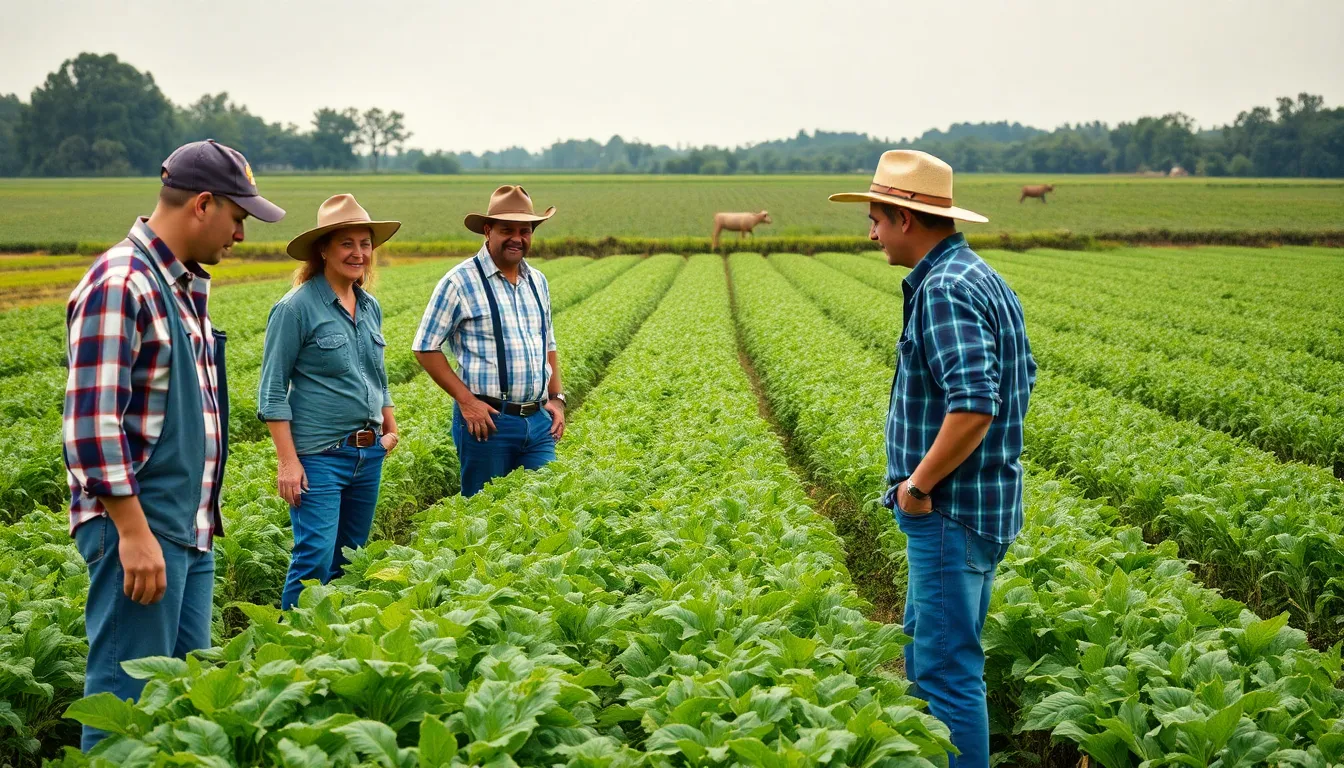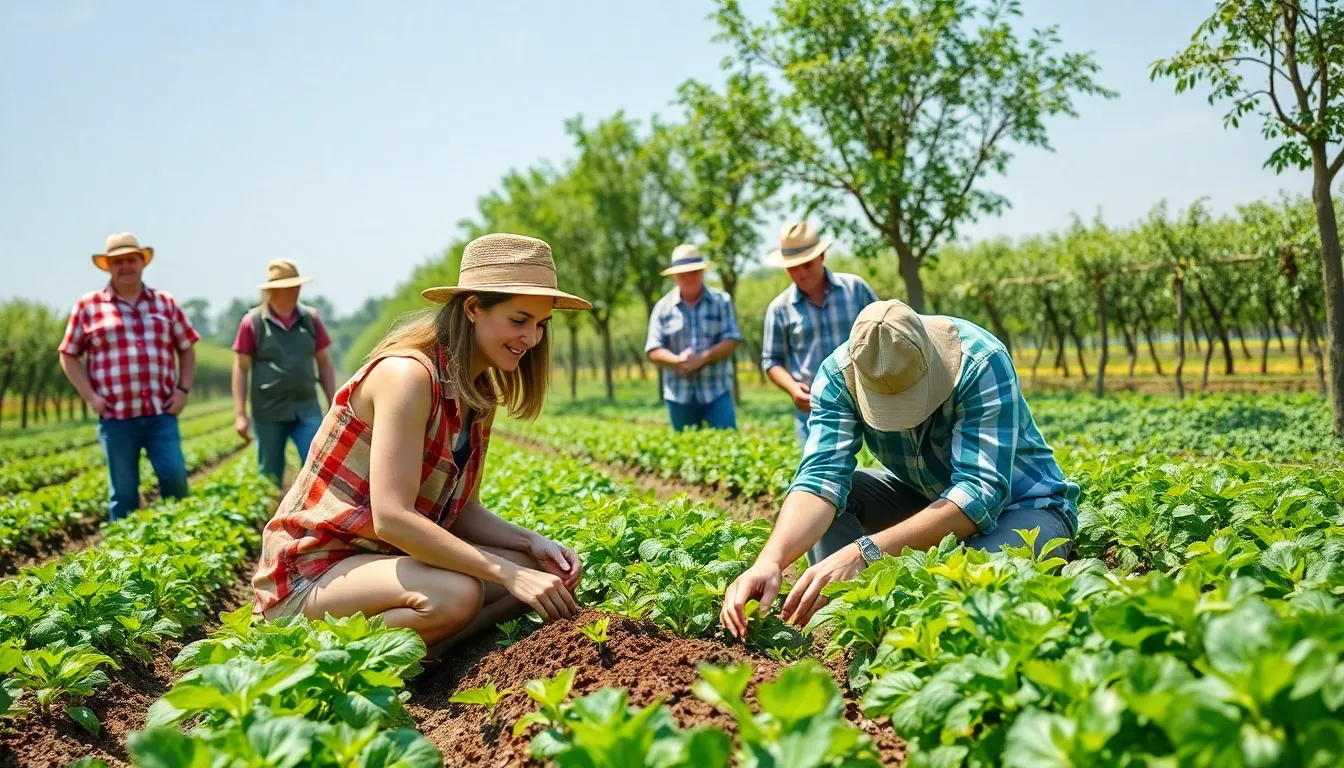Sustainable agriculture methods are transforming the way food is produced, ensuring that practices meet the needs of the present without compromising future generations. With the global population on the rise and climate change posing significant challenges, farmers and researchers are exploring innovative techniques that promote environmental health, economic viability, and social equity.
These methods prioritize long-term productivity and ecosystem balance, moving away from conventional practices that often deplete resources. From crop rotation and organic farming to agroforestry and permaculture, sustainable agriculture offers a diverse range of approaches that can enhance soil fertility, conserve water, and reduce reliance on synthetic chemicals. As awareness grows, the adoption of these practices is becoming essential for a resilient food system.
Table of Contents
ToggleOverview of Sustainable Agriculture Methods
Sustainable agriculture methods encompass a range of practices designed to maintain environmental health, economic viability, and social equity. Crop rotation involves alternating different crops in a particular area across seasons, enhancing soil fertility and reducing pests and diseases. Organic farming focuses on using natural inputs and methods, promoting biodiversity and soil health while avoiding synthetic chemicals.
Agroforestry integrates trees and shrubs into agricultural landscapes, improving biodiversity and providing additional income sources for farmers. It fosters ecological balance and enhances resource management. Permaculture emphasizes designing agricultural systems that mimic natural ecosystems, creating self-sustaining environments.
Conservation tillage minimizes soil disruption, reducing erosion and improving soil structure. Cover cropping involves growing specific plants during off-seasons to enhance soil nutrients and prevent weed growth. Integrated pest management addresses pest control using ecological principles, reducing reliance on chemical pesticides.
These methods not only support food production but also contribute to climate change mitigation. By enhancing soil quality and managing resources efficiently, sustainable agriculture methods play a critical role in ensuring food security for future generations.
Key Principles of Sustainable Agriculture

Sustainable agriculture relies on key principles that ensure practices are environmentally sound, economically viable, and socially responsible. These principles form the foundation for methods that contribute to long-term food security and resource preservation.
Environmental Stewardship
Environmental stewardship prioritizes the protection and enhancement of natural ecosystems. Practices include:
- Soil Conservation: Techniques like cover cropping and reduced tillage maintain soil structure and health, diminishing erosion and nutrient loss.
- Water Management: Efficient irrigation systems and rainwater harvesting promote water conservation, essential in water-scarce regions.
- Biodiversity Promotion: Crop diversification fosters resilience against pests and diseases, enhancing ecosystem stability and reducing reliance on chemical inputs.
- Habitat Restoration: Enhancing local habitats supports wildlife, which contributes to pollination and pest control.
Economic Viability
Economic viability ensures that sustainable practices are financially sustainable for farmers. Essential aspects include:
- Cost-Effective Techniques: Practices such as organic farming can reduce input costs over time and create premium market opportunities.
- Value-Added Products: Farmers can enhance profitability by selling organic or locally sourced products, catering to consumer demand for sustainability.
- Market Accessibility: Establishing networks and cooperatives allows farmers to strengthen market access, sharing resources and reducing costs.
- Long-Term Soil Health: Investing in soil health translates to improved yields and reduced need for synthetic fertilizers, leading to long-term savings.
Social Responsibility
Social responsibility emphasizes fair treatment and equity within agricultural communities. Key components include:
- Community Engagement: Involving local communities in decision-making promotes shared ownership and enhances social cohesion.
- Fair Labor Practices: Ensuring fair wages and safe working conditions for all laborers supports equitable growth and community health.
- Education and Training: Providing resources and training to farmers enhances their capabilities, allowing for sustainable practices to flourish.
- Food Sovereignty: Supporting local food systems empowers communities to control their food sources, promoting self-sufficiency and resilience.
These principles of sustainable agriculture create impactful and effective frameworks for addressing the challenges in food production and environmental conservation, ensuring a healthier planet and society.
Types of Sustainable Agriculture Methods
Sustainable agriculture encompasses various methods that enhance productivity while preserving the environment. The following sections detail specific approaches that farmers use to promote sustainability.
Organic Farming
Organic farming prioritizes natural processes and seeks to maintain ecological balance. It avoids synthetic fertilizers and pesticides, instead using organic inputs such as compost and cover crops. This method promotes soil health through practices like crop rotation and biodiversity enhancement, leading to increased resilience against pests and diseases. Studies indicate that organic farms often yield comparable results to conventional farms while fostering healthier ecosystems.
Agroecology
Agroecology integrates ecological principles into agricultural practices, focusing on the relationship between plants, animals, and their environment. It emphasizes local knowledge and community involvement in food production. By incorporating diverse cropping systems and minimizing external inputs, agroecology enhances soil health and reduces reliance on chemical inputs. Research shows this approach can increase crop productivity by 20-30% over traditional methods, while also improving resilience to climate change.
Permaculture
Permaculture design mimics natural ecosystems to create self-sustaining agricultural systems. It integrates diverse plant and animal species to work synergistically, ensuring efficient use of resources. Key principles include observation, maximizing productivity with minimal intervention, and maintaining biodiversity. Permaculture practices enhance soil fertility, conserve water, and reduce waste. Implementing permaculture techniques can lead to increased yields while promoting ecological stability.
Regenerative Agriculture
Regenerative agriculture focuses on restoring and enhancing soil health. This method includes practices such as cover cropping, reduced tillage, and rotational grazing. By building organic matter and improving soil structure, regenerative agriculture promotes carbon sequestration and increases water retention. Research indicates that regenerative practices can improve yield resilience by 10-20% in varying climates while reducing overall agricultural emissions, contributing significantly to climate change mitigation efforts.
Benefits of Sustainable Agriculture
Sustainable agriculture offers a wide range of benefits that contribute to environmental health, economic stability, and social equity. By employing practices that respect natural ecosystems, it enhances food production systems for current and future generations.
Environmental Benefits
Sustainable agriculture significantly boosts environmental health. It enhances soil fertility through practices like crop rotation and cover cropping, which prevent erosion and promote nutrient cycling. Water conservation methods, such as efficient irrigation systems, reduce water usage and minimize runoff. Biodiversity thrives in sustainable systems, with integrated pest management reducing reliance on chemical pesticides. Overall, these practices contribute to climate change mitigation by sequestering carbon, restoring ecosystems, and protecting natural resources.
Economic Advantages
Economic benefits emerge from adopting sustainable agriculture. Financial viability strengthens through cost-effective farming practices that lower input costs. Sustainable methods often increase crop yields and market access, allowing farmers to tap into premium markets for organic and locally sourced products. Reduced long-term costs associated with soil degradation and pest management further enhance profitability. Sustainable agriculture systems can create new job opportunities in emerging green sectors, fostering a resilient agricultural economy.
Social Impact
Sustainable agriculture promotes social responsibility within farming communities. Fair labor practices ensure equitable treatment for workers, fostering safer working conditions. Community engagement initiatives encourage local participation in agricultural planning, enhancing food sovereignty. Education and training programs boost knowledge and skills, supporting farmers in transitioning to sustainable practices. By prioritizing social equity, sustainable agriculture strengthens community bonds while addressing food insecurity.
Challenges in Implementing Sustainable Agriculture
Implementing sustainable agriculture methods involves various challenges that can hinder progress. These obstacles require attention for successful adoption and effectiveness.
Technological Barriers
Technological barriers play a significant role in the adoption of sustainable agriculture. Many farmers face difficulties accessing advanced agricultural technology, which can enhance productivity and sustainability. Limited internet connectivity in rural areas restricts access to research and information on sustainable practices. High initial costs of innovative tools, such as precision agriculture systems, can deter investment. Furthermore, inadequate training on new technologies prevents effective utilization, leaving farmers reliant on traditional methods.
Policy and Regulation Issues
Policy and regulation issues complicate the transition to sustainable agriculture. Existing agricultural policies often prioritize conventional farming practices, creating an imbalance that disadvantages sustainable methods. Lack of supportive legislation for organic practices and conservation efforts limits farmer participation. Additionally, bureaucratic red tape can slow the approval process for sustainable projects, creating uncertainty and reducing investment. Clear, coherent policies are essential to support farmers in adopting environmentally friendly practices.
Market Accessibility
Market accessibility poses challenges for sustainable agriculture. Many farmers experience difficulties reaching consumers who value sustainably produced goods. Limited access to markets can hinder profitability and discourage sustainable practices. Moreover, a lack of consumer awareness about the benefits of sustainable products reduces demand. Certification processes for organic and sustainable goods can be time-consuming and costly, further limiting market entry. Expanding market access and improving consumer education are crucial for boosting the adoption of sustainable agriculture methods.
Sustainable agriculture methods represent a vital shift towards a more resilient food system. By integrating practices that prioritize environmental health and social equity, farmers can enhance productivity while minimizing their ecological footprint. The adoption of techniques like organic farming and agroforestry not only supports current agricultural needs but also safeguards resources for future generations.
As challenges persist, it’s essential for stakeholders to collaborate on solutions that promote sustainable practices. Increased awareness and education can empower communities to embrace these methods, ensuring food security and environmental sustainability. The future of agriculture hinges on these innovative approaches, paving the way for a healthier planet and thriving agricultural communities.



